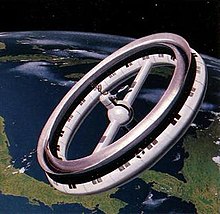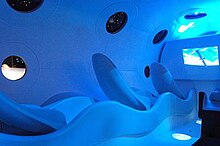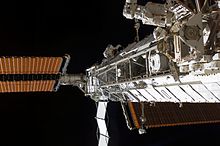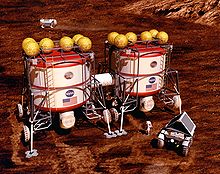Space architecture

Space architecture is the theory and practice of designing and building inhabited environments in outer space.[1] This mission statement for space architecture was developed at the World Space Congress in Houston in 2002 by members of the Technical Aerospace Architecture Subcommittee of the American Institute of Aeronautics and Astronautics (AIAA). The architectural approach to spacecraft design addresses the total built environment. It is mainly based on the field of engineering (especially aerospace engineering), but also involves diverse disciplines such as physiology, psychology, and sociology.
Like architecture on Earth, the attempt is to go beyond the component elements and systems and gain a broad understanding of the issues that affect design success.[2] Space architecture borrows from multiple forms of niche architecture to accomplish the task of ensuring human beings can live and work in space. These include the kinds of design elements one finds in “tiny housing, small living apartments/houses, vehicle design, capsule hotels, and more.”[3]
Much space architecture work has been in designing concepts for orbital space stations and lunar and Martian exploration ships and surface bases for the world's space agencies, chiefly NASA.
The practice of involving architects in the space program grew out of the
Etymology
The word space in space architecture is referring to the outer space definition, which is from English outer and space. Outer can be defined as "situated on or toward the outside; external; exterior" and originated around 1350–1400 in
Architecture, the concatenation of architect and -ure, dates to 1563, coming from Middle French architecte. This term is of Latin origin, formerly architectus, which came from Greek arkhitekton. Arkitekton means "master builder" and is from the combination of arkhi- "chief" and tekton "builder".[6] The human experience is central to architecture – the primary difference between space architecture and spacecraft engineering.
There is some debate over the terminology of space architecture. Some consider the field to be a specialty within architecture that applies architectural principles to space applications. Others such as Ted Hall of the University of Michigan see space architects as generalists, with what is traditionally considered architecture (Earth-bound or terrestrial architecture) being a subset of a broader space architecture.[7] Any structures that fly in space will likely remain for some time highly dependent on Earth-based infrastructure and personnel for financing, development, construction, launch, and operation. Therefore, it is a matter of discussion how much of these earthly assets are to be considered part of space architecture. The technicalities of the term space architecture are open to some level of interpretation.
Origins
Ideas of people traveling to space were first published in science fiction stories, like Jules Verne's 1865 From the Earth to the Moon. In this story several details of the mission (crew of three, spacecraft dimensions, Florida launch site) bear striking similarity to the Apollo Moon landings that took place more than 100 years later. Verne's aluminum capsule had shelves stocked with equipment needed for the journey such as a collapsing telescope, pickaxes and shovels, firearms, oxygen generators, and even trees to plant. A curved sofa was built into the floor and walls and windows near the tip of the spacecraft were accessible by ladder.[8] The projectile was shaped like a bullet because it was gun-launched from the ground, a method infeasible for transporting man to space due to the high acceleration forces produced. It would take rocketry to get humans to the cosmos.

The first serious theoretical work published on space travel by means of rocket power was by
The flight of Yuri Gagarin on April 12, 1961, was humanity's maiden spaceflight. While the mission was a necessary first step, Gagarin was more or less confined to a chair with a small view port from which to observe the cosmos – a far cry from the possibilities of life in space. Following space missions gradually improved living conditions and quality of life in low Earth orbit. Expanding room for movement, physical exercise regimens, sanitation facilities, improved food quality, and recreational activities all accompanied longer mission durations. Architectural involvement in space was realized in 1968 when a group of architects and industrial designers led by Raymond Loewy, over objections from engineers, prevailed in convincing NASA to include an observation window in the Skylab orbital laboratory.[11] This milestone represents the introduction of the human psychological dimension to spacecraft design. Space architecture was born.[neutrality is disputed]
Theory
The subject of architectural theory has much application in space architecture. Some considerations, though, will be unique to the space context.
Ideology of building

In the first century BC, the Roman architect
Some theorists[who?] link different elements of the Vitruvian triad. Walter Gropius writes:
'Beauty' is based on the perfect mastery of all the scientific, technological and formal prerequisites of the task ... The approach of Functionalism means to design the objects organically on the basis of their own contemporary postulates, without any romantic embellishment or jesting.[13]
As space architecture continues to mature as a discipline, dialogue on architectural design values will open up just as it has for Earth.
Analogs

A starting point for space architecture theory is the search for
Space missions, especially human ones, require extensive preparation. In addition to terrestrial analogs providing design insight, the analogous environments can serve as testbeds to further develop technologies for space applications and train astronaut crews. The
In space
Fundamental to space architecture is designing for physical and psychological wellness in space. What often is taken for granted on Earth – air, water, food, trash disposal – must be designed for in fastidious detail. Rigorous exercise regimens are required to alleviate muscular atrophy and other effects of space on the body. That space missions are (optimally) fixed in duration can lead to stress from isolation. This problem is not unlike that faced in remote research stations or military tours of duty, although non-standard gravity conditions can exacerbate feelings of unfamiliarity and homesickness. Furthermore, confinement in limited and unchanging physical spaces appears to magnify interpersonal tensions in small crews and contribute to other negative psychological effects.[18] These stresses can be mitigated by establishing regular contact with family and friends on Earth, maintaining health, incorporating recreational activities, and bringing along familiar items such as photographs and green plants.[19] The importance of these psychological measures can be appreciated in the 1968 Soviet 'DLB Lunar Base' design:
...it was planned that the units on the Moon would have a false window, showing scenes of the Earth countryside that would change to correspond with the season back in Moscow. The exercise bicycle was equipped with a synchronized film projector, that allowed the cosmonaut to take a 'ride' out of Moscow with return.[20]

The challenge of getting anything at all to space, due to launch constraints, has had a profound effect on the physical shapes of space architecture.[21] All space habitats to date have used modular architecture design. Payload fairing dimensions (typically the width but also the height) of modern launch vehicles limit the size of rigid components launched into space. This approach to building large scale structures in space involves launching multiple modules separately and then manually assembling them afterward. Modular architecture results in a layout similar to a tunnel system where passage through several modules is often required to reach any particular destination. It also tends to standardize the internal diameter or width of pressurized rooms, with machinery and furniture placed along the circumference. These types of space stations and surface bases can generally only grow by adding additional modules in one or more direction. Finding adequate working and living space is often a major challenge with modular architecture. As a solution, flexible furniture (collapsible tables, curtains on rails, deployable beds) can be used to transform interiors for different functions and change the partitioning between private and group space. For more discussion of the factors that influence shape in space architecture, see the Varieties section.
A notable difference between the orbital context of space architecture and Earth-based architecture is that structures in orbit do not need to support their own weight. This is possible because of the microgravity condition of objects in free fall. In fact much space hardware, such as the Space Shuttle ''s robotic arm, is designed only to function in orbit and would not be able to lift its own weight on the Earth's surface.[24] Microgravity also allows an astronaut to move an object of practically any mass, albeit slowly, provided he or she is adequately constrained to another object. Therefore, structural considerations for the orbital environment are dramatically different from those of terrestrial buildings, and the biggest challenge to holding a space station together is usually launching and assembling the components intact. Construction on extraterrestrial surfaces still needs to be designed to support its own weight, but its weight will depend on the strength of the local gravitational field.
Ground infrastructure
Human spaceflight currently[
Varieties
Suborbital
Structures that cross the
SpaceShip
This section's factual accuracy is disputed. (December 2017) |

On June 21, 2004,
The architecture of the SpaceShipTwo vehicle is somewhat different from what is common in previous space vehicles. Unlike the cluttered interiors with protruding machinery and many obscure switches of previous vehicles, this cabin looks more like something out of science fiction than a modern spacecraft. Both SS2 and the carrier aircraft are being built from lightweight composite materials instead of metal.
Orbital
Orbital architecture is the architecture of structures designed to
International Space Station

The International Space Station (ISS) is the only permanently inhabited structure currently in space. It is the size of an American football field and has a crew of six. With a living volume of 358 m³, it has more interior room than the cargo beds of two American 18-wheeler trucks.[29] However, because of the microgravity environment of the space station, there are not always well-defined walls, floors, and ceilings and all pressurized areas can be used as living and working space. The International Space Station is still under construction. Modules were primarily launched using the Space Shuttle until its deactivation and were assembled by its crew with the help of the working crew on board the space station. ISS modules were often designed and built to barely fit inside the shuttle's payload bay, which is cylindrical with a 4.6 meter diameter.[30]
Life aboard the space station is distinct from terrestrial life in some very interesting ways. Astronauts commonly "float" objects to one another; for example they will give a clipboard an initial nudge and it will coast to its receiver across the room. In fact, an astronaut can become so accustomed to this habit that they forget that it doesn't work anymore when they return to Earth.
When a shuttle is operating in low Earth orbit, the ISS serves as a safety refuge in case of
A typical day on the station might start with wakeup at 6:00 am inside a private soundproof booth in the crew quarters.[35] Astronauts would probably find their sleeping bags in an upright position tied to the wall, because orientation does not matter in space. The astronaut's thighs would be lifted about 50 degrees off the vertical.[36] This is the neutral body posture in weightlessness – it would be excessively tiring to "sit" or "stand" as is common on Earth. Crawling out of his booth, an astronaut may chat with other astronauts about the day's science experiments, mission control conferences, interviews with Earthlings, and perhaps even a space walk or space shuttle arrival.
Bigelow Aerospace
Bigelow Aerospace took the unique step in securing two patents NASA held from development of the Transhab concept in regard to inflatable space structures. The company now has sole rights to commercial development of the inflatable module technology.[37] On July 12, 2006, the Genesis I experimental space habitat was launched into low Earth orbit. Genesis I demonstrated the basic viability of inflatable space structures, even carrying a payload of life science experiments. The second module, Genesis II, was launched into orbit on June 28, 2007, and tested out several improvements over its predecessor. Among these are reaction wheel assemblies, a precision measurement system for guidance, nine additional cameras, improved gas control for module inflation, and an improved on-board sensor suite.[38]
While Bigelow architecture is still modular, the inflatable configuration allows for much more interior volume than rigid modules. The
Bigelow Aerospace may choose to launch many of their modules independently, leasing their use to a wide variety of companies, organizations, and countries that can't afford their own space programs. Possible uses of this space include microgravity research and
Lunar
Apollo
On the cruise to the Moon, Apollo astronauts had two "rooms" to choose from – the
The Lunar Module had two stages. A pressurized upper stage, termed the ascent stage, was the first true spaceship as it could only operate in the vacuum of space. The descent stage carried the engine used for descent, landing gear and radar, fuel and consumables, the famous ladder, and the
Every astronaut who walked on the Moon tracked in lunar dust, contaminating the LM and later the CM during
Constellation program
The
Even NASA has described Constellation architecture as 'Apollo on steroids'.[44] Nonetheless, a return to the proven capsule design is a move welcomed by many.[45]
Martian
Martian architecture is architecture designed to sustain human life on the surface of
Von Braun and other early proposals
Von Braun was aware of the threat posed by extended exposure to weightlessness. He suggested either tethering passenger ships together to spin about a common center of mass or including self-rotating, dumbbell-shaped "gravity cells" to drift alongside the flotilla to provide each crew member with a few hours of artificial gravity each day.
The Soviet Union conducted studies of human exploration of Mars and came up with slightly less epic mission designs (though not short on exotic technologies) in 1960 and 1969.
Recent initiatives
In every serious study of what it would take to land humans on Mars, keep them alive, and then return them to Earth, the total mass required for the mission is simply stunning. The problem lies in that to launch the amount of consumables (oxygen, food and water) even a small crew would go through during a multi-year Mars mission, it would take a very large rocket with the vast majority of its own mass being propellant. This is where multiple launches and assembly in Earth orbit come from. However even if such a ship stocked full of goods could be put together in orbit, it would need an additional (large) supply of propellant to send it to Mars. The delta-v, or change in velocity, required to insert a spacecraft from Earth orbit to a Mars transfer orbit is many kilometers per second. When we think of getting astronauts to the surface of Mars and back home we quickly realize that an enormous amount of propellant is needed if everything is taken from the Earth. This was the conclusion reached in the 1989 '90-Day Study' initiated by NASA in response to the Space Exploration Initiative.

Several techniques have changed the outlook on Mars exploration. The most powerful of which is in-situ resource utilization. Using hydrogen imported from Earth and carbon dioxide from the Martian atmosphere, the Sabatier reaction can be used to manufacture methane (for rocket propellant) and water (for drinking and for oxygen production through electrolysis). Another technique to reduce Earth-brought propellant requirements is aerobraking. Aerobraking involves skimming the upper layers of an atmosphere, over many passes, to slow a spacecraft down. It's a time-intensive process that shows most promise in slowing down cargo shipments of food and supplies. NASA's Constellation program does call for landing humans on Mars after a permanent base on the Moon is demonstrated, but details of the base architecture are far from established. It is likely that the first permanent settlement will consist of consecutive crews landing prefabricated habitat modules in the same location and linking them together to form a base.[54]
In some of these modern, economy models of the Mars mission, we see the crew size reduced to a minimal 4 or 6. Such a loss in variety of social relationships can lead to challenges in forming balanced social responses and forming a complete sense of identity.
A number of specific habitat design proposals have been put forward, to varying degrees of architectural and engineering analysis. One recent proposal—and the winner of NASA's 2015 Mars Habitat Competition—is Mars Ice House. The design concept is for a Mars surface habitat,
Robotic
It is widely accepted that robotic reconnaissance and trail-blazer missions will precede human exploration of other worlds. Making an informed decision on which specific destinations warrant sending human explorers requires more data than what the best Earth-based telescopes can provide. For example, landing site selection for the Apollo Moon landings drew on data from three different robotic programs: the Ranger program, the Lunar Orbiter program, and the Surveyor program. Before a human was sent, robotic spacecraft mapped the lunar surface, proved the feasibility of soft landings, filmed the terrain up close with television cameras, and scooped and analysed the soil.[57]
A robotic exploration mission is generally designed to carry a wide variety of scientific instruments, ranging from cameras sensitive to particular wavelengths, telescopes,
The modern, balanced approach to exploring an extraterrestrial destination involves several phases of exploration, each of which needs to produce rationale for progressing to the next phase. The phase immediately preceding human exploration can be described as anthropocentric sensing, that is, sensing designed to give humans as realistic a feeling as possible of actually exploring in person. More, the line between a human system and a robotic system in space is not always going to be clear. As a general rule, the more formidable the environment, the more essential robotic technology is. Robotic systems can be broadly considered part of space architecture when their purpose is to facilitate the habitation of space or extend the range of the physiological
Future
The future of space architecture hinges on the expansion of
The classic space mission is the Earth-colliding asteroid interception mission. Using nuclear detonations to split or deflect the asteroid is risky at best. Such a tactic could actually make the problem worse by increasing the amount of asteroid fragments that do end up hitting the Earth. Robert Zubrin writes:
If bombs are to be used as asteroid deflectors, they cannot just be launched willy-nilly. No, before any bombs are detonated, the asteroid will have to be thoroughly explored, its geology assessed, and subsurface bomb placements carefully determined and precisely located on the basis of such knowledge. A human crew, consisting of surveyors, geologists, miners, drillers, and demolition experts, will be needed on the scene to do the job right.[58]

If such a crew is to be summoned to a distant asteroid, there may be less risky ways to divert the asteroid. Another promising
When motivations to go into space are realized, work on mitigating the most serious threats can begin. One of the biggest threats to astronaut safety in space is sudden radiation events from
Nobody knows what the long-term human future in space will be. Perhaps after gaining experience with routine spaceflight by exploring different worlds in the Solar System and deflecting a few asteroids, the possibility of constructing non-modular space habitats and infrastructure will be within capability.[
Further reading
- Space Architecture Education for Engineers and Architects - Designing and Planning Beyond Earth by Haeuplik-Meusburger and Bannova, 2016
- International Space Station - Architecture Beyond Earth by David Nixon, 2016
- Space Architecture: The New Frontier for Design Research by Neal Leach (Ed.), 2014
- Architecture for Astronauts - an Activity based Approach by Haeuplik-Meusburger, 2011 [63]
- Out of this World - The new Field of Space Architecture by Scott Howe and Brent Sherwood (Ed.), 2009
Gallery
-
The International Space Station in its 2010 configuration
-
Many life support technologies have been adapted from the submarine.
-
A Soyuz spacecraft docked to the Mir Core Module.
-
A hypothetical spacecraft performing Mars orbit rendezvous.
-
1989 painting of Mars surface operations.
-
The Bernal sphere is an example of non-modular space architecture.
-
Artificial gravity can be created by spinning a space colony.
-
Dyson Sphereis the structure for creating space settlements in space and Dyson spheres around different space objects
See also
- Aerospace architecture – Discipline of architectural design
- Infrastructure – Facilities and systems serving society
- Infrastructure-based development – Development based on long-term infrastructure investments
- Planetary surface construction – Construction of structures on planetary surface
- Research station – Facility for scientific research
- Space colonization – Concept of permanent human habitation outside of Earth
- Shackleton Energy Company – formed in 2007 with the goal to prepare the equipment and technologies necessary for mining the Moon
- Space telescope, also known as Space observatory – Instrument in space to study astronomical objects
- Space tourism – Human space travel for recreation
- Underground construction – Field of engineering for the design and construction of structures below the ground
- Underwater construction – Industrial construction in an underwater environment
References
- ^ Sherwood, Brent (2006-09-21). "Organizing Ourselves: Schema to Build the International Space Architecture Community" (PDF). Concluding Address. San Jose, Calif.: AIAA. Archived from the original (PDF) on 2011-01-31. Retrieved 2009-10-24.
- ^ "Sasakawa International Center for Space Architecture". University of Houston. 2009-08-18. Retrieved 2009-10-28.
- ^ Williams, Matt (2020-06-17). "What Does it Mean to Be a Space Architect?". Universe Today. Retrieved 2020-07-02.
- ^ "outer". Dictionary.com Unabridged (v 1.1). Random House, Inc. Retrieved 2009-09-23.
- ^ Harper, Douglas. "space (n.)". Online Etymology Dictionary. Retrieved 2009-09-23.
- ^ Harper, Douglas. "architect". Online Etymology Dictionary. Retrieved 2009-09-23.
- ^ Adams, Constance (2002-10-12). "(Aero)Space Architecture takes flight". Houston: Spacearchitect.org. Retrieved 2009-10-14.
- ^ Wolcott, Norman (December 2005). "A Jules Verne Centennial: 1905–2005". Smithsonian Institution Libraries. Retrieved 2009-10-13.
- ^ "Konstantin E. Tsiolkovsky". New Mexico Museum of Space History. New Mexico Department of Cultural Affairs. 2005–2009. Retrieved 2009-10-14.
- ^ Barry, Patrick (2000-05-26). "Wheels in the Sky". NASA. Archived from the original on 2009-10-04. Retrieved 2009-10-15.
- ^ "Spacearchitect.org". AIAA. Retrieved 2009-09-14.
- ^ Thayer, Bill (2008-06-17). "Marcus Vitruvius Pollio: de Architectura, Book I". University of Chicago. Retrieved 2009-09-06.
- ^ Routio, Pentti (2004-03-31). "Thematic Theories of Architecture". University of Arts and Design Helsinki. Retrieved 2009-09-14.
- ^ Bannova, Olga (2008-03-03). Terrestrial Analogs for Planetary Surface Facility Planning and Operations (PDF). Long Beach, Calif.: ASCE. Retrieved 2009-10-25.
- ^ Havely, Joe (2002-02-15). "Air Force One: 'The Flying White House'". CNN. Hong Kong. Archived from the original on 22 April 2010. Retrieved 2022-08-28.
- ^ "Submarine Frequently Asked Questions". Chief of Naval Operations. Archived from the original on 2013-08-02. Retrieved 2009-09-16.
- ^ Zubrin, Robert (2003-12-30). "Exploring Mars on Earth". BBC. Retrieved 2009-09-18.
- ^ a b "Space Environments". Living Aloft: Human Requirements for Extended Spaceflight. NASA. Retrieved 2009-10-22.
- ^ "Plants in Space" (PDF). Human Exploration and Development of Space Enterprise. NASAexplores. 2001-08-02. Retrieved 2009-10-24. [dead link]
- ^ Wade, Mark (1997–2008). "DLB Lunar Base". Encyclopedia Astronautica. Archived from the original on November 16, 2005. Retrieved 2009-10-22.
- ISBN 9783709106662.
- ^ Ochshorn, Jonathan (2006-08-10). "Designing Building Failures". Cornell University. Archived from the original on 5 January 2010. Retrieved 2022-08-30.
- ISBN 0-15-501104-9.
- ^ Dean, Brandi (2006-11-09). "Space Shuttle Canadarm Robotic Arm Marks 25 Years in Space". Space Shuttle. NASA. Retrieved 2009-10-24.
- ^ "Captain Kirk signs on for Virgin Galactic Space Ride". SoulTek.com. 2004-10-22. Archived from the original on 2007-09-29. Retrieved 2009-10-02.
- ^ "What is the difference between a Virgin Galactic spaceship and a NASA shuttle?". Virgin Galactic. 2009. Archived from the original on 2009-10-05. Retrieved 2009-10-24.
- ^ "What will the experience be like?". Virgin Galactic. 2009. Archived from the original on 2008-06-16. Retrieved 2009-10-03.
- ^ LaFee, Scott (2008-09-11). "Up, up and unweigh". SignOnSanDiego. Union-Tribune. Archived from the original on 2008-09-16. Retrieved 2009-10-23.
- ^ NASA (2009-06-10). "The ISS to Date". NASA. Archived from the original on 2002-06-03. Retrieved 2009-08-25.
- ^ "Technical Overview of the Space Shuttle Orbiter". ColumbiasSacrifice.com. 2004-06-15. Archived from the original on 2009-04-16. Retrieved 2009-10-06.
- ^ Pomeroy, Ross (January 8, 2021). "The Funniest Side Effect of Returning to Earth From Space". realclearscience.com. Retrieved April 27, 2023.
- ^ Kloeris, Vickie (2001-05-01). "Eating on the ISS". NASA Quest. NASA. Archived from the original on 2006-09-30. Retrieved 2009-10-02.
- ^ Sang-Hun, Choe (2008-02-22). "Kimchi goes to space, along with first Korean astronaut". New York Times. Seoul. Retrieved 2009-10-06.
- ^ "International Foods". International Partnership in Space. NASA. 2009-05-28. Archived from the original on 2009-07-25. Retrieved 2009-10-06.
- ^ Mansfield, Cheryl L. (2008-11-07). "Station Prepares for Expanding Crew". International Space Station. NASA. Retrieved 2009-10-25.
- ^ "Anthropometry and Biomechanics". Man-Systems Integration Standards. NASA. 2008-05-07. Retrieved 2009-10-25.
- ^ David, Leonard (2004-05-24). "Bigelow Aerospace to Tackle Inflatable Space Habitats". Space.com. Retrieved 2009-09-01.
- ^ "Genesis II". Bigelow Aerospace, LLC. Archived from the original on 2009-10-05. Retrieved 2009-09-29.
- ^ Coppinger, Rob (2009-09-09). "NASA considers ISS Bigelow module". Flightglobal. Archived from the original on 12 September 2009. Retrieved 2022-08-31.
- ^ "NASA to Test Bigelow Expandable Module on Space Station". NASA. January 16, 2013. Retrieved January 30, 2017.
- ^ Foust, Jeff (2020-03-23). "Bigelow Aerospace lays off entire workforce". SpaceNews. Retrieved 2020-07-02.
- ^ "The Origin of the Moon". Planetary Science Institute. Retrieved 2009-11-03.
- ^ Woods, David; O' Brian, Frank (2004). "Apollo 8". Apollo Flight Journal. NASA. Archived from the original on 2007-10-02. Retrieved 2009-10-29.
- ^ Cohen, Don (February 2006). "Interview With Michael Coats". Insight. ASK NASA. Retrieved 2009-11-02.
- ^ Liston, Broward (2003-09-02). "A Return to Apollo?". TIME. Archived from the original on September 5, 2003. Retrieved 2009-10-30.
- ^ NASA (2008-07-31). "NASA Spacecraft Confirms Martian Water, Mission Extended". Science@NASA. Retrieved 2009-10-29.
- ^ "NASA Images Suggest Water Still Flows in Brief Spurts on Mars". NASA/JPL. 2006-12-06. Retrieved 2009-10-29.
- ISBN 1-4013-0149-5.
- ^ a b Wade, Mark (1997–2008). "Von Braun Mars Expedition – 1952". Encyclopedia Astronautica. Archived from the original on 2010-01-16. Retrieved 2009-09-18.
- ISBN 978-0-252-06227-8.
- ^ "The 1969 Project". Martian Mission. Energia. Archived from the original on 4 March 2016. Retrieved 2009-09-18.
- ^ "The 1960 Project". Martian Mission. Energia. Archived from the original on 4 March 2016. Retrieved 2009-09-18.
- ^ Wade, Mark (1997–2008). "Mars Expeditions". Encyclopedia Astronautica. Archived from the original on 2010-09-03. Retrieved 2009-10-06.
- ^ ISBN 0-684-83550-9.
- ^ "3D-Printed Ice Houses Win NASA's Mars Habitat Competition". Huffington Post. 2015-10-05. Retrieved 2015-10-13.
- ^ "Mars Ice House". Mars Ice House. 2015-10-20. Retrieved 2022-03-23.
- ^ Williams, David (2006-10-05). "Surveyor (1966–1968)". NASA. Retrieved 2009-08-31.
- ISBN 1-58542-036-0.
- ISBN 0-345-37659-5.
- ^ "Space Radiation Threats To Astronauts Addressed In Federal Research Study". Boulder, Colo.: University of Colorado. 2006-10-25. Archived from the original on 2010-02-21. Retrieved 2009-10-07.
- ^ Globus, Al (June 1995). "Problem Two: Radiation Shielding". Georgia Institute of Technology. Retrieved 2009-11-04.
- ISBN 0-520-22453-1.
- ISBN 978-3-7091-0666-2.
External links
- Spacearchitect.org
- Sasakawa International Center for Space Architecture (SICSA)
- Cullen College of Engineering In 2015, this Master of Science in Space Architecture was changed to the Department of Mechanical Engineering as an interdisciplinary graduate program at the Cullen College of Engineering.
- International Space University (ISU)
- International Conference on Environmental Systems (ICES)
- Flashline Mars Arctic Research Station (FMARS)
- Evaluation of Space Habitats (Apollo, Salyut, Skylab, Mir Space Station, Shuttle, International Space Station) according to Human Activities (Sleep, Hygiene, Food, Work, Leisure)









